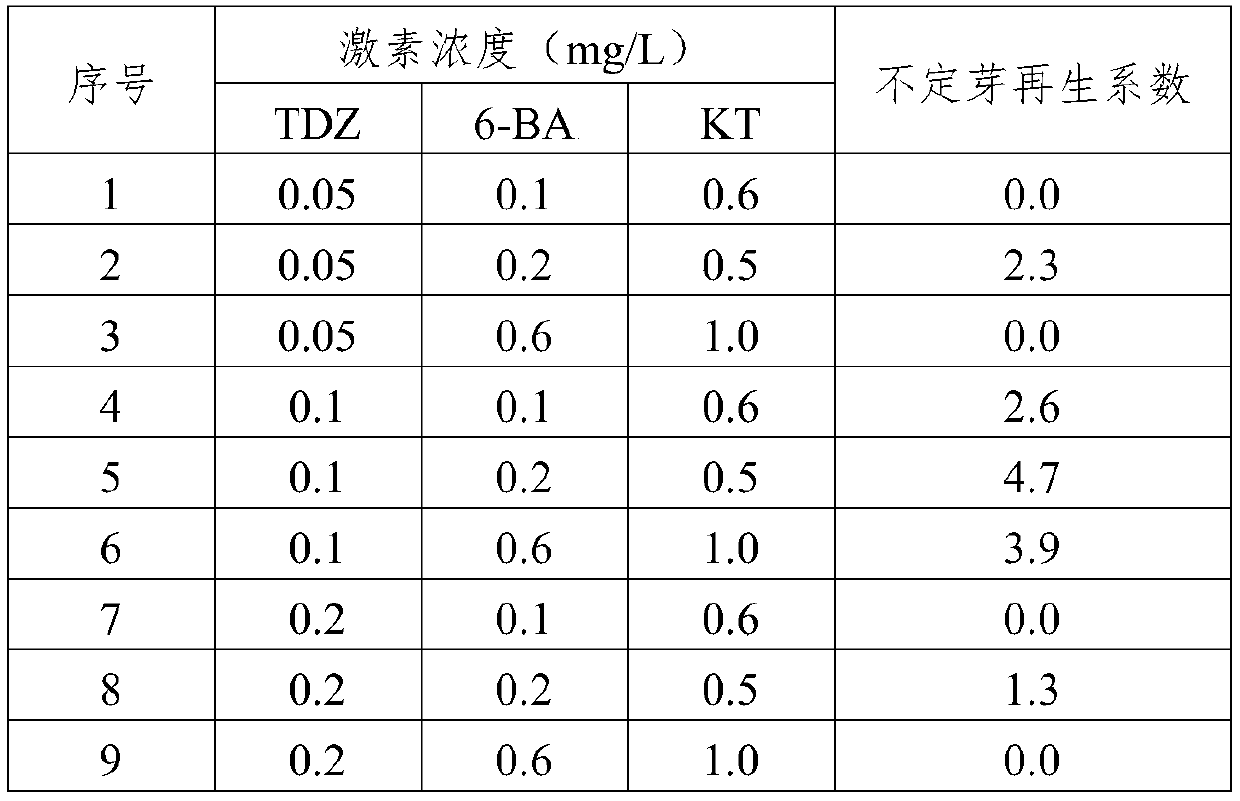Method for callus and adventitious bud induction of quercus variabilis
A technology of callus induction and callus, which is applied in the field of plant biology, can solve the problems of imperfect asexual reproduction system and low tissue culture proliferation coefficient, and achieve the effect of expanding the propagation coefficient of adventitious buds
- Summary
- Abstract
- Description
- Claims
- Application Information
AI Technical Summary
Benefits of technology
Problems solved by technology
Method used
Image
Examples
Embodiment 1
[0019] Example 1 Screening Quercus variabilis callus induction medium
[0020] The mature seeds of a fine single plant of Quercus variabilis were used as explants, and after low-temperature storage at 4°C for 30 days, they were treated with 0.2% HgCl under sterile conditions. 2 Disinfect the surface for 10-15 minutes, rinse with sterile water 3 to 4 times, and put it in MS plus activated carbon 1.5g / L medium for germination culture. The culture temperature is 25±2°C, the light intensity is 800-1000Lux, and the light cycle is 16h / d; when the seedlings of Quercus cork grow 3-6cm high and the root length is 1-1.5cm, the root system is circumcised with a sterile blade. The circumcision depth does not reach the xylem, inoculated in the callus induction medium, the callus induction medium is based on MS, WPM, B5 culture, 6-BA0.5mg / L, 1.0mg / L, 1.50mg / L L, IAA0.1mg / L, 0.3mg / L, 0.8mg / L carry out orthogonal design induction culture (see Table 1), 6 repetitions. The relative humidity o...
Embodiment 2
[0024] Example 2 Screening Quercus variabilis callus proliferation medium
[0025] The induced Quercus variabilis callus was cultured on the basis of WPM, 6-BA0.3mg / L, 0.6mg / L, 0.9mg / L, IAA0.1mg / L, 0.2mg / L, 0.3mg / L for orthogonal Proliferation culture was designed, with 6 repetitions, the relative humidity of the culture room was 70%±5%, the temperature was (24±1)°C, and dark culture was carried out. After 20 days, the proliferation of callus on each culture medium was observed and analyzed.
[0026] It was observed that the culture medium for the proliferation of Quercus variabilis callus is preferably WPM solid medium: 6-BA0.6mg / L, IAA0.2mg / L.
Embodiment 3
[0027] Example 3 Screening callus differentiation induction medium for adventitious buds
[0028] The callus after proliferation was transferred to the differentiation medium for differentiation culture experiment. The medium used WPM as the basic medium, and different concentrations of TDZ, 6-BA, and KT growth regulators were added. See Table 2 for details. Each treatment was inoculated with 6 mediums, and each medium was inoculated with 5 pieces of embryogenic callus. The relative humidity of the culture room was 70%±5%, the temperature was (24±1)°C, cultured under LED light, the photoperiod was 8h·d-1, and the number of adventitious bud regeneration was counted after 35 days of culture.
[0029] Table 2 Differentiation coefficients on different media
[0030]
[0031] Differentiation factor = number of adventitious buds produced / number of inoculated explants
[0032] As can be seen from Table 2, the embryogenic callus has the highest adventitious bud regeneration coef...
PUM
 Login to View More
Login to View More Abstract
Description
Claims
Application Information
 Login to View More
Login to View More - R&D Engineer
- R&D Manager
- IP Professional
- Industry Leading Data Capabilities
- Powerful AI technology
- Patent DNA Extraction
Browse by: Latest US Patents, China's latest patents, Technical Efficacy Thesaurus, Application Domain, Technology Topic, Popular Technical Reports.
© 2024 PatSnap. All rights reserved.Legal|Privacy policy|Modern Slavery Act Transparency Statement|Sitemap|About US| Contact US: help@patsnap.com









